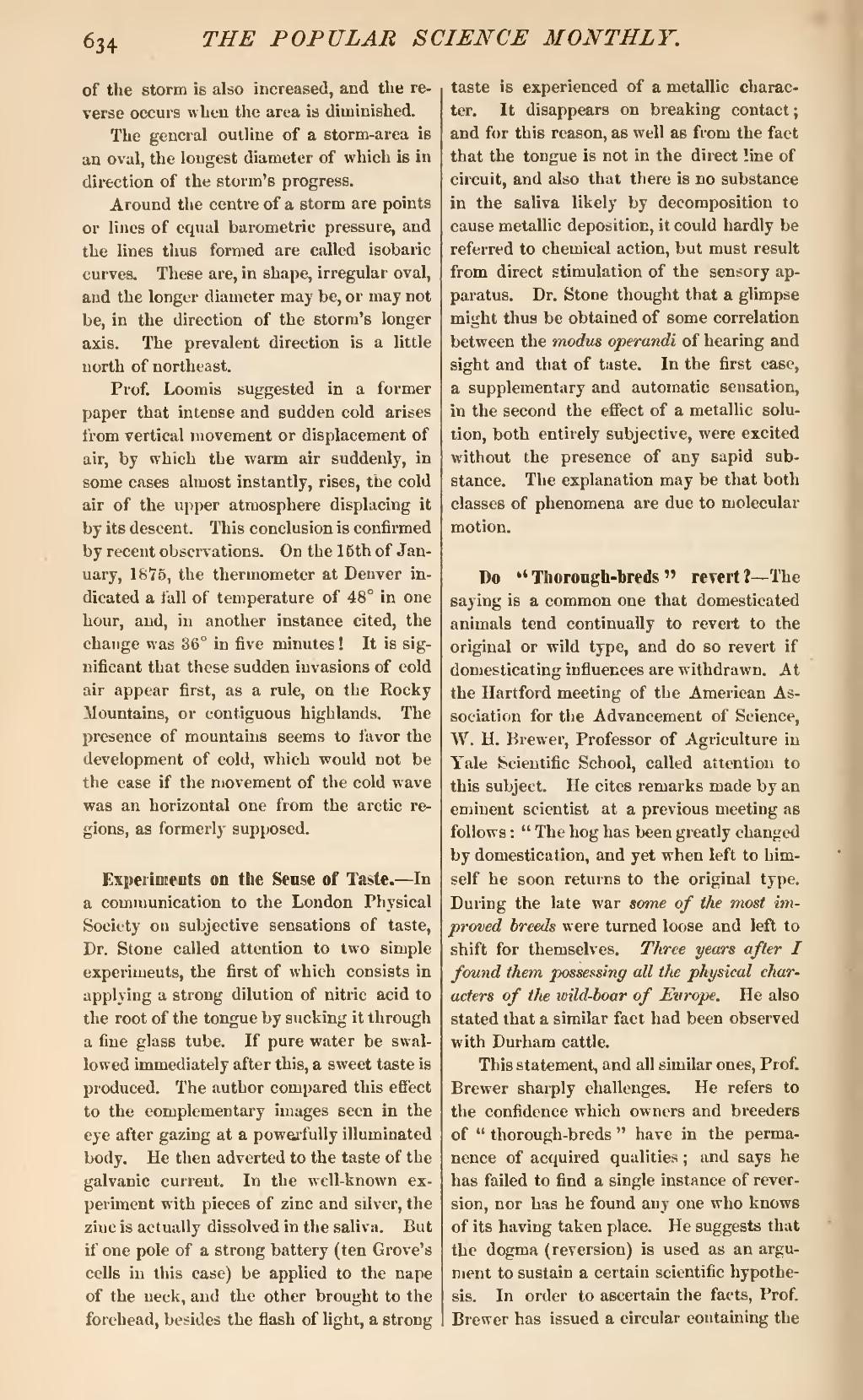of the storm is also increased, and the reverse occurs when the area is diminished.
The general outline of a storm-area is an oval, the longest diameter of which is in direction of the storm's progress.
Around the centre of a storm are points or lines of equal barometric pressure, and the lines thus formed are called isobaric curves. These are, in shape, irregular oval, and the longer diameter may be, or may not be, in the direction of the storm's longer axis. The prevalent direction is a little north of northeast.
Prof. Loomis suggested in a former paper that intense and sudden cold arises from vertical movement or displacement of air, by which the warm air suddenly, in some cases almost instantly, rises, the cold air of the upper atmosphere displacing it by its descent. This conclusion is confirmed by recent observations. On the 15th of January, 1875, the thermometer at Denver indicated a fall of temperature of 48° in one hour, and, in another instance cited, the change was 36° in five minutes! It is significant that these sudden invasions of cold air appear first, as a rule, on the Rocky Mountains, or contiguous highlands. The presence of mountains seems to favor the development of cold, which would not be the case if the movement of the cold wave was an horizontal one from the arctic regions, as formerly supposed.
Experiments on the Sense of Taste.—In a communication to the London Physical Society on subjective sensations of taste, Dr. Stone called attention to two simple experiments, the first of which consists in applying a strong dilution of nitric acid to the root of the tongue by sucking it through a fine glass tube. If pure water be swallowed immediately after this, a sweet taste is produced. The author compared this effect to the complementary images seen in the eye after gazing at a powerfully illuminated body. He then adverted to the taste of the galvanic current. In the well-known experiment with pieces of zinc and silver, the zinc is actually dissolved in the saliva. But if one pole of a strong battery (ten Grove's cells in this case) be applied to the nape of the neck, and the other brought to the forehead, besides the flash of light, a strong taste is experienced of a metallic character. It disappears on breaking contact; and for this reason, as well as from the fact that the tongue is not in the direct line of circuit, and also that there is no substance in the saliva likely by decomposition to cause metallic deposition, it could hardly be referred to chemical action, but must result from direct stimulation of the sensory apparatus. Dr. Stone thought that a glimpse might thus be obtained of some correlation between the modus operandi of hearing and sight and that of taste. In the first case, a supplementary and automatic sensation, in the second the effect of a metallic solution, both entirely subjective, were excited without the presence of any sapid substance. The explanation may be that both classes of phenomena are due to molecular motion.
Do "Thorough-breds" revert?—The saying is a common one that domesticated animals tend continually to revert to the original or wild type, and do so revert if domesticating influences are withdrawn. At the Hartford meeting of the American Association for the Advancement of Science, W. H, Brewer, Professor of Agriculture in Yale Scientific School, called attention to this subject. He cites remarks made by an eminent scientist at a previous meeting as follows: "The hog has been greatly changed by domestication, and yet when left to himself he soon returns to the original type. During the late war some of the most improved breeds were turned loose and left to shift for themselves. Three years after I found them possessing all the physical characters of the wild-boar of Europe. He also stated that a similar fact had been observed with Durham cattle.
This statement, and all similar ones. Prof. Brewer sharply challenges. He refers to the confidence which owners and breeders of "thorough-breds" have in the permanence of acquired qualities; and says he has failed to find a single instance of reversion, nor has he found any one who knows of its having taken place. He suggests that the dogma (reversion) is used as an argument to sustain a certain scientific hypothesis. In order to ascertain the facts, Prof. Brewer has issued a circular containing the
